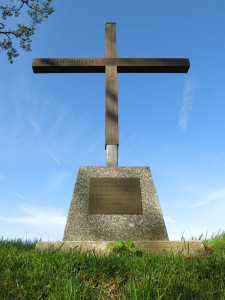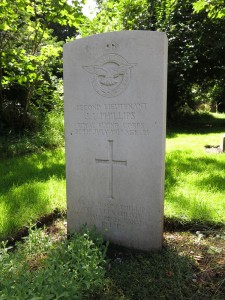2nd Lt Joseph Leo Phillips was a Canadian trainee pilot with the Royal Flying Corps. The son of Joseph and Ellen Christie Phillips of Ottawa, he joined the Royal Flying Corps in the spring of 1917.
 During 1917 the demand for trained pilots became critical following the Battle of Arras, known in the RFC as Bloody April, when new pilots’ life expectancy was measured in weeks or even days. During April the RFC lost 245 aircraft, 211 pilots and observers killed or missing and 108 prisoners of war. Just as in the Battle of Britain twenty three later, aircraft were easier to replace than pilots. 2nd Lt Phillips was one of those trainee pilots attached to 25 Training Squadron based at Snarehill Aerodrome near Thetford in Norfolk.
During 1917 the demand for trained pilots became critical following the Battle of Arras, known in the RFC as Bloody April, when new pilots’ life expectancy was measured in weeks or even days. During April the RFC lost 245 aircraft, 211 pilots and observers killed or missing and 108 prisoners of war. Just as in the Battle of Britain twenty three later, aircraft were easier to replace than pilots. 2nd Lt Phillips was one of those trainee pilots attached to 25 Training Squadron based at Snarehill Aerodrome near Thetford in Norfolk.
At about 4.50 am on July 20th 1917 2nd Lt Phillips took off from Snarehill in an obsolescent Maurice Farman Shorthorn biplane on his second solo flight. A contemporary account of what followed was published in the Eastern Daily Press of 24th July. It tells a sorry tale of the collision of the exigencies of war and the fragility of a new technology.
It seems that shortly after take-off 2nd Lt Phillips lost sight of the airfield and disappeared from view. His instructor, 2nd Lt Russell went out to look for him at 6 am, 7 am and 9.30 am without success. At 11 am he received a telephone message that 2nd Lt Phillips had landed near Harleston and was badly injured. By the time Russell arrived at the scene at Redenhall, Phillips had already been taken to hospital. The plane had come down in a field of standing corn and appeared to have turned over completely twice. The position of the controls indicated that the plane was on almost full power when it hit the ground. Fortunately, given the ignition was still on and sparking, the plane did not catch fire.
But did he simply lose sight of the airfield? Phillips was a young man with a sense of adventure (or else he would not have joined the RFC) and that sure and certain sense of invulnerability of youth. It was less than fourteen years since the Wright Brothers’ first flight and he was one of the relatively few people who could fly an aeroplane. He had sat through the theory lectures and dual control flights with his instructor. He had just completed his first solo flight, taken off, made a few circuits of the airfield and landed, just as instructed. It’s not hard to imagine how elated he must have felt as he took off into the dawn of a mid summer’s morning, up, around and down again, him and nobody else.
He could fly.
When he took off a few minutes later for his second solo flight, buzzing with excitement and full of confidence, he climbed away from the airfield and flew due east towards the rising sun, up and up like Icarus into the light, and away from this world for ever.
John Smith, a labourer, was the only witness to the crash. At about 5.30 am he heard an aircraft overhead and went outside in time to see it head towards a wheat field a few hundred yards away. He lost sight of it behind some trees and then heard a crash. When he got to the aircraft he found 2nd Lt Phillips had been thrown from the cockpit and was unconscious on the ground, moaning. After Dr Maidment had arrived, Phillips was taken to the Norfolk and Norwich Hospital where he died later that day without regaining consciousness. He was 21 years old.
At his inquest on 23rd July, the Deputy Coroner Mr W N Ladell recorded a verdict of “Death caused accidentally by a fall from an aeroplane”
Beyond all this though is the sad story of a young man with no shortage of enthusiasm and confidence but a great lack of flying experience. In the aftermath of Bloody April in a desperate attempt to replace lost pilots and observers, the Royal Flying Corps repeatedly reduced the length of training for new recruits and Phillips was a victim of that reduction. He had been flying for less than three weeks and had logged less than three and a half hours dual control flying time. He had made his first twenty minute solo flight only that morning. Lacking training and ill-prepared, he found himself either lost or with a failing aircraft. It is heartbreaking to imagine his last minutes; alone and frightened, desperately trying to find somewhere to land. Possibly misjudging the height of the standing wheat, he seems to have lost control of the aircraft and flown into the ground on full throttle.
 2nd Lt Phillips is buried in Earlham Cemetery in Norwich. His plot, 24/147, is marked by a Commonwealth War Graves Commission headstone. He is also remembered in the Canadian First World War Book of Remembrance on page 580 and on the St Catharine’s War Memorial in Ottawa.
2nd Lt Phillips is buried in Earlham Cemetery in Norwich. His plot, 24/147, is marked by a Commonwealth War Graves Commission headstone. He is also remembered in the Canadian First World War Book of Remembrance on page 580 and on the St Catharine’s War Memorial in Ottawa.
The original wooden memorial to 2nd Lt Phillips is thought to have been erected by Mrs Sancroft Holmes of Gawdy Hall very near the site where his plane crashed, and over the years it has been repaired and renewed by the people of Harleston. The latest simple memorial, the wooden cross a replica of the original which is in Harleston Museum*, was dedicated on July 20th 2011 in the presence of members of the Royal Canadian Air Force and the RAF.
This simple and often unregarded wooden cross beside a quiet and little used country lane in South Norfolk is one of our overlooked commemorations of the Great War.
*Harleston Museum has more information about 2nd Lt. Phillips, including the Eastern Daily Press article. If anyone can track down a picture of him we and they would love to see it.


Very interesting. Joseph was my great, great uncle. I am trying to gather photographs and information on him which of course has become more difficult with the passing of the more senior members of the family.